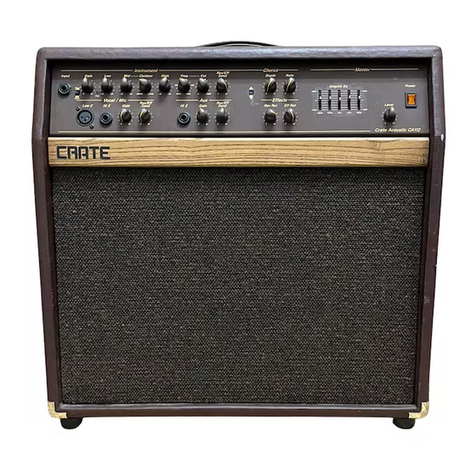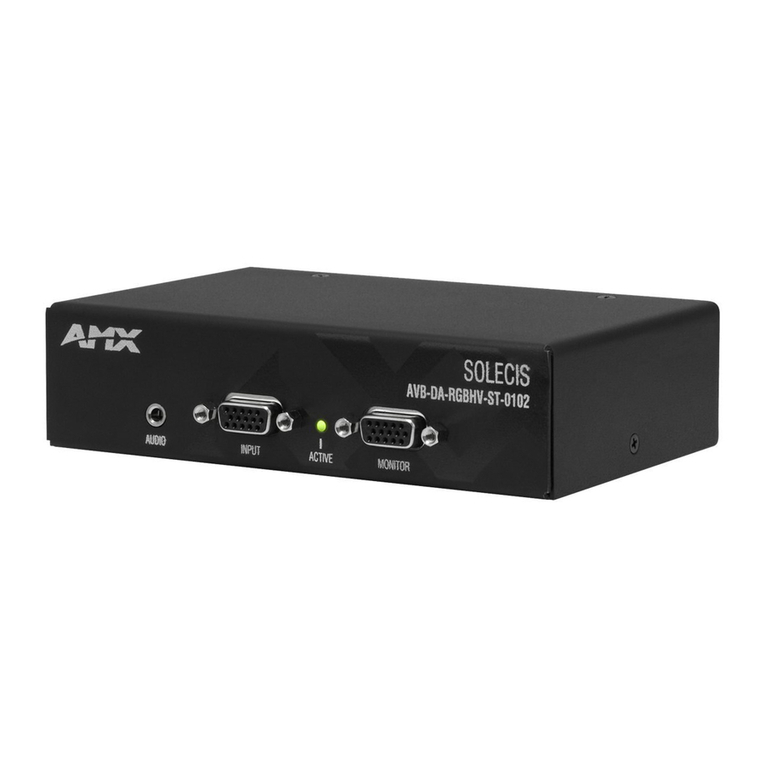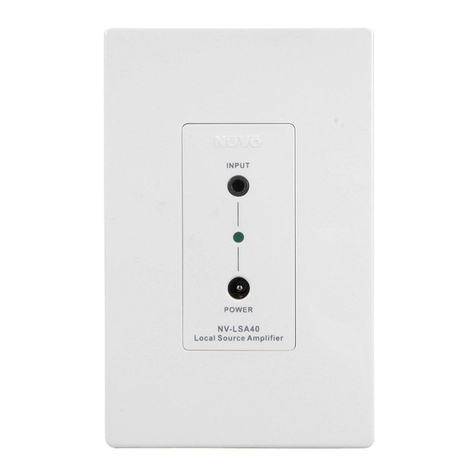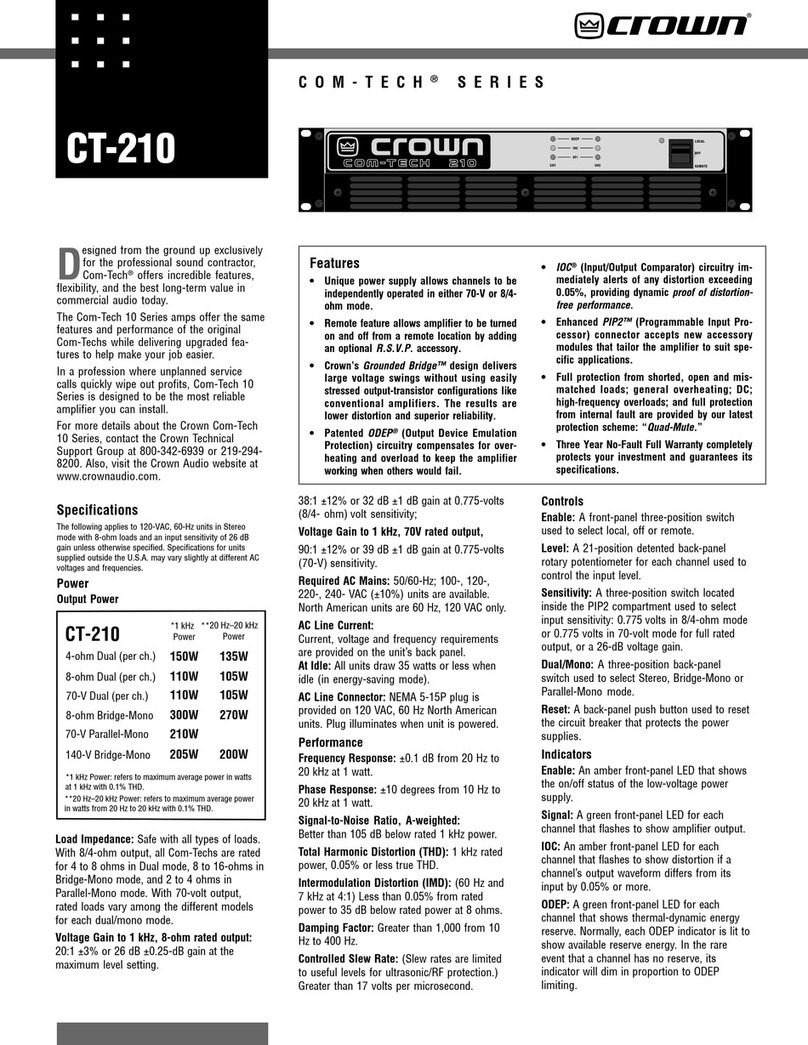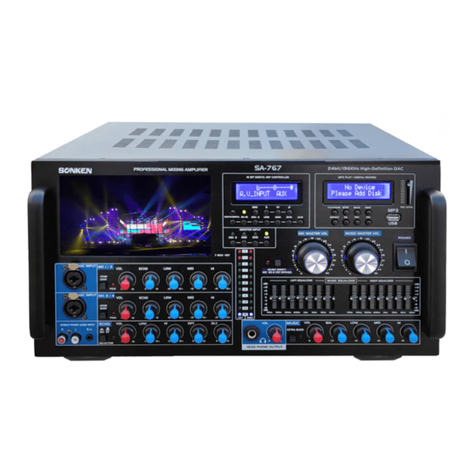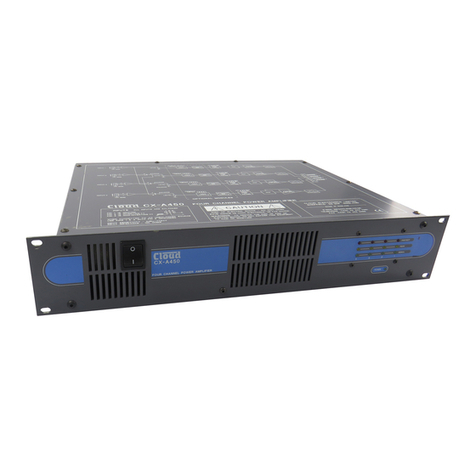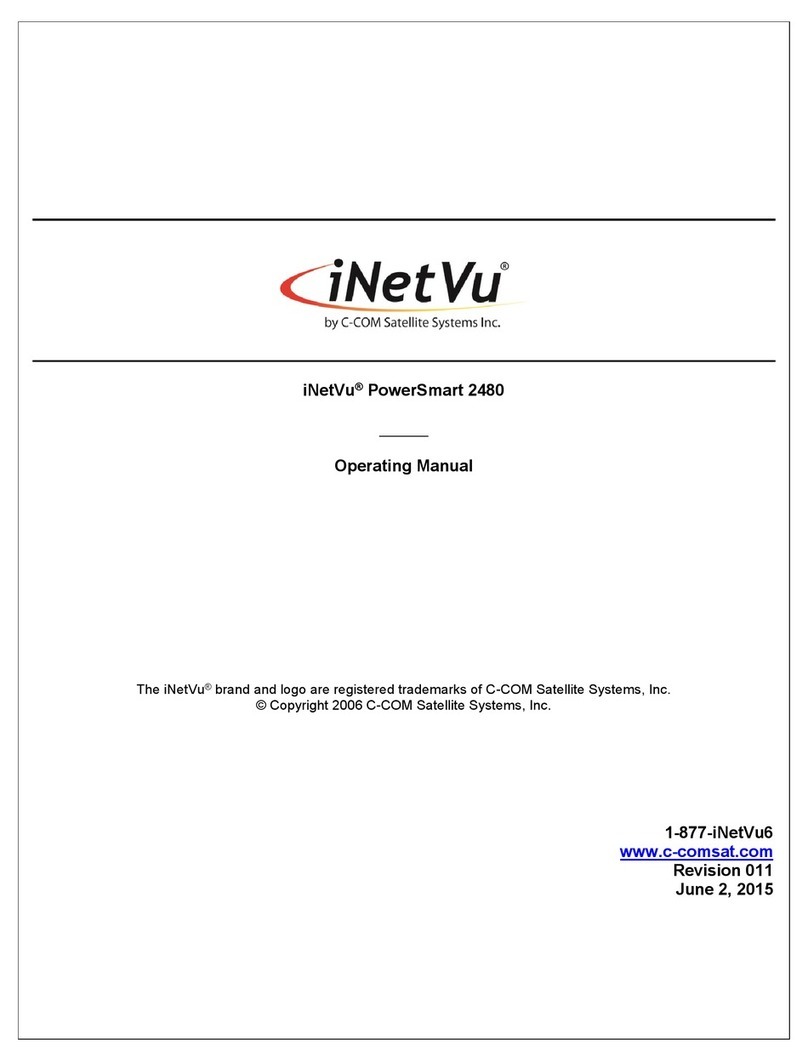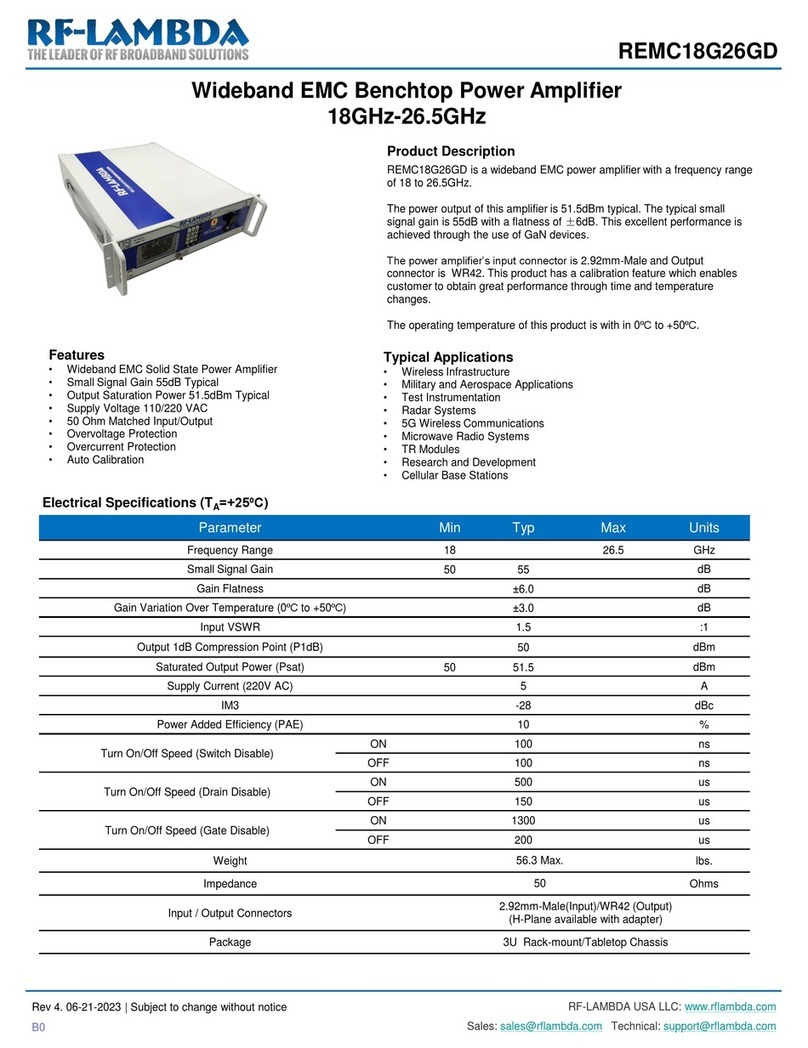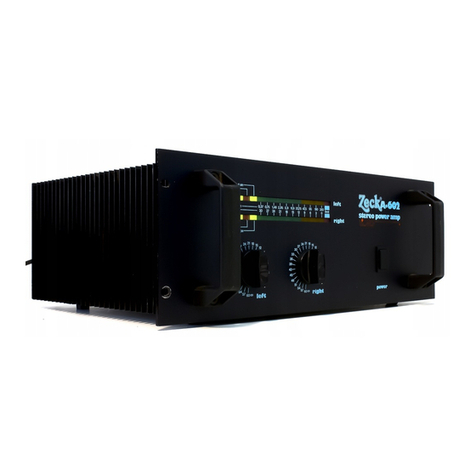Tone King Royalist MK III User manual

1
User’s Manual
Tone King Amplifiers
www.ToneKing.com

2
Thank you for choosing Tone King’s “Royalist MK III” guitar amplifier. The
original Royalist was the first Tone King amp to deliver the best elements of the
British sound and was one of our most beloved amps.
This new Royalist MKIII expands on that legacy with new features and
enhancements, faithfully producing early British tones ranging from the sweet,
singing JTM45 to the iconic “Plexi”sound, all the way to the raging “Super
Lead”.The Royalist MKIII captures the authentic vintage nature of these iconic
amplifiers delivering tones that span from clean to edge-of-breakup, to the
bright, crunchy sounds found on countless classic rock tracks that shaped
music history.
The Royalist MKIII offers three important updates over its predecessor: dual
channels with independent Volume and Pull FAT feature; 1964, 1967 and 1970
voicing switch assignable to each channel and two of our legendary Iron Man
attenuators with independent level for each the channels.
Both channels share a classic tone control circuit (Treble, Midrange and Bass)
and Presence control. The combination of the Royalist MKIII controls provide a
wide palette of British tones from beautiful cleans to the heaviest of old school
British tones.
We thank you for choosing the Royalist MK III, and hope you enjoy playing it as
much as we do.

3
Please keep this instruction manual for future reference and for the duration of owning
this Tone King Amplifier. Please carefully read and understand the instructions inside
this user’s manual before attempting to operate your new amp. This instruction manual
includes essential safety information regarding the use and maintenance of the
amplifier. Take special care to heed all warning symbols and signs inside this manual
and those printed on the amplifier itself.
INSTRUCTIONS
WARNING!
TO PREVENT FIRE OR SHOCK HAZARD, DO NOT EXPOSE THE AMPLIFIER TO
WATER OR MOISTURE. DO NOT OPERATE NEAR ANY WATER SOURCE
WHAT’S THE MEANING OF THIS?
The lightning flash with an arrow triangular symbol is intended to alert the user to the
presence of non-insulated “dangerous voltage” within the products enclosure, and may
be of sufficient magnitude to constitute a risk of electric shock
WHAT’S THE MEANING OF THIS?
The exclamation point triangular symbol is intended to alert the user to the presence of
important operating and maintenance (servicing) instructions in the user manual
accompanying this amplifier!
1. Read Instructions –All the safety and operating instructions should be read before
this product is operated.
2. Retain Instructions –The safety and operating instructions should be retained for
future reference.
3. Heed Warnings –All warnings on the amplifier and in the operating instructions
should be adhered to.
4. Follow Instructions –All operating and use instructions should be followed.
5. Water and Moisture –The amplifier should not be used near water –for example, a
bathtub, washbowl, kitchen sink, laundry tub, wet basement, or near a swimming pool,
and the like.
6. Heat –Amplifier should be situated away from heat sources such as radiators, heat
registers, stoves, or other amplifier (including amplifiers) that produce heat.
7. Power Sources –This product should be operated only from the type of power source
indicated on the rating label.
If you are not sure of the type of power supply to your home, consult your product
dealer or local power company.
8. Grounding or Polarization
–This product may be equipped with a polarized alternation-current line plug (a plug
having one blade wider than the other). This plug will fit into the power outlet only one
way. This is a safety feature. If you are unable to insert the plug fully into the outlet, try
reversing the plug. If the plug should still fail to fit, contact your electrician to replace
your obsolete outlet. Do not defeat the safety purpose of the polarized plug.
9. Power-Cord Protection

4
–Power-supply cords should be routed so that they are not likely to be walked on or
pinched by items placed upon or against them, paying particular attention to the cord
in correspondence of plugs, convenience receptacles, and the point where they exit from
the amplifier.
10. Cleaning –The amplifier should be cleaned only as recommended by the
manufacturer. Clean by wiping with a cloth slightly damp with water. Avoid getting
water inside the amplifier.
11. Non-use Periods –The power cord of the amplifier should be unplugged from the
outlet when left unused for a long period of time.
12. Object and Liquid Entry
–Care should be taken so that objects do not fall and liquids are not spilled into the
enclosure through openings.
13. Damage Requiring Service
–The amplifier should be serviced by qualified service personnel when:
A. The power-supply cord or the plug has been damaged; or
B. Objects have fallen, or liquid has been spilled into the amplifier; or
C. The amplifier has been exposed to rain; or
D. The amplifier does not appear to operate normally or exhibits a marked change in
performance; or
E. The amplifier has been dropped, or the enclosure damaged.
F. The amplifier needs tube replacement or biasing
14. Servicing –The user should not attempt any service to the amplifier beyond that
described in the operating instructions.
All other servicing should be referred to qualified service personnel.
15. Ventilation –Slots and openings in the cabinet are provided for ventilation and to
ensure reliable operation of the product and to protect it from overheating, and these
openings must not be blocked or covered.
16. Attachments –do not use attachments not recommended by the product
manufacturer as they may cause hazards.
17. Accessories –Do not place this product on an unstable cart, stand, tripod, bracket,
or table. The product may fall, causing serious injury to a child or adult, and serious
damage to the product. Use only with a cart, stand, tripod, bracket, or table
recommended by the manufacturer, or sold with the product.
18. Lightning –For added protection for this product before a lightning storm, or when
it is left unattended and unused for long periods of time, unplug it from the wall outlet.
This will prevent damage to the product due to lightning and power line surges.
19. Replacement Parts –When replacement parts are required, be sure the service
technician has used replacement parts specified by the manufacturer or have the same
characteristics as the original part. Unauthorized substitutions may result in fire,
electric shock, or other hazards.
20. Safety Check –Upon completion of any service or repairs to this product, ask the
service technician to perform safety checks to determine that the product is in proper
operating condition.
21. FUSES –Always use the correct rating and type of fuse as indicated on the rear
panel. Note the proper rating fuse is determined by the AC line voltage in the country
this unit is being operated.

5
1. Front Panel Controls
6
Two Preamp Channels –Channel A & B
6
Channel select switch
6
Volume controls (A & B)
6
Tone Controls
6
Presence Control
6
Voicing Switches
6
Attenuator Controls (A & B)
7
Foot Switch
7
2. Dialing In Your Sound
7
Starting Point
7
Notes on using the attenuator
8
3. Back Panel Control
9
AC Power
9
Mains Fuse
9
Plate Fuse
9
Power Switch, Standby Switch
9
Footswitch
9
Power Switch, Standby Switch
9
Impedance Switch
9
Speaker Jack
9
Line Out
10
4. Ironman Attenuator
10
Purpose of the Attenuator
10
Attenuator Controls
10
How to Use The Attenuator
10
HF Comp Switch
11
5. Getting a Great Sound at Home
12
The Effect of Your Acoustical Environment
12
Floor Reflections
12
Where to Place the Amp
12
Carpeting
12
Backwards Amp Trick
13
The Attenuator Can Help
13
6. Tube Installation and Replacement
14
Choice of Tube types
14
Installing Tubes
14
Replacing Output Tubes
14
Tube Quality
15
7. Custom Celestion "1660" 12” Speaker
8. Warranty
15
16-17

6
The Royalist MKIII has two identical foot-switchable channels (A & B). Each channel
has an independent volume (gain) control, three position “Era”voicing switch and
independent attenuator rotary control. Both channels share the same tone controls
and presence control.
Selects channel A or B when footswitch is not being used.
The two independent volume controls (A&B) adjust the amount of gain in the preamp
circuit. Each volume control has a PULL FAT feature, which when pulled allows more
low-end frequencies in the first preamp gain stage.
These controls should be familiar, as they operate in the same way as most other guitar
amplifiers, with the Treble knob controlling the high frequencies, the Bass knob
controlling the low frequencies, and the Midrange knob controlling the frequencies
between bass and treble.
The Royalist MKIII is a non-master-volume design, which means that overdrive and
distortion are generated by both the preamp and power amp in certain predetermined
proportions. This makes it relatively easy to dial in the amount of overdrive and
distortion you want –it’s all under control of the single Volume knob.
The Presence knob adjusts the level of very high frequencies (those above the range of
the Treble control) and does it in a way that is slightly different than the Treble control.
As you turn the Presence knob up, the level of those very high frequencies is increased,
as you would expect. But, the presence control also has an effect on the “feel” of the
amp as well. At higher settings, the amp is punchier and more “raw” sounding, while at
lower settings is less “spiky”, with a more “compressed” feel.
It’s a good idea to get used to the specific effect of the Presence control, as it can really
help to dial in your sound for a particular room or setting. As a general rule, you may
find it appropriate to set the presence control higher in larger rooms, but keep it rather
low at home.
The 1964, 1967 and 1970 three-position “era” voicing switch on each channel allows
you to choose the particular preamp, tone stack and negative feedback (power amp)
from three of the most popular vintage British amps.
1964 - delivers a balanced treble response, lower gain, and less aggressive attack of a
vintage JTM45 or Bluesbreaker.
1967 - delivers the crisp treble response and aggressive attack of a vintage “Plexi”.
1970 - this highest gain setting on the Royalist MKIII delivers the raging “Super Lead”
sound.

7
The Royalist contains a built-in Ironman-II precision attenuator for each channel
designed specifically for this model. The attenuator allows you to reduce the volume
level of the amplifier while retaining the natural overdrive sound and feel of the
amplifier. The tone and feel that this amplifier is designed for are best achieved by a
certain proportion of preamp distortion to power tube distortion, so an attenuator is the
best way to control volume level while preserving that balance.
This attenuator uses a precision tuned reactive load and volume compensation circuitry
to best preserve the natural tone and feel of the amp, even at very low volume. This is
the same general approach used in the highly regarded Ironman-II Mini standalone
attenuator.
There are many different approaches that can be used to generate overdriven and
distorted tones as a low volume. For example, master volume circuits, or a power
reduction scheme such as London Power Scaling have both been used successfully on
various amp models of other brands. However, for the vintage British tones that the
Royalist MKIII is designed to achieve, a good quality attenuator such as the built-in
Ironman is the best way to preserve tone and feel at very low volume, because it allows
the output stage to participate in overdrive, lending an authentic vintage British quality
to the response of the amp.
The attenuation control determines the amount of power sent to the speaker, but does
not affect the operation of the output stage of the amplifier itself. The attenuator
absorbs and dissipates any excess power generated by the output tubes that is not sent
to the speaker.
The attenuator is internally connected between the amplifier output and the speaker
jack –the same way an external attenuator would be connected. However, the input of
the attenuator is not accessible, so you cannot use the built-in Ironman attenuator to
attenuate the output of some other amplifier.
The LED on the footswitch indicates the channel selected. When the LED is lit, channel
B is selected. When the LED is off, channel A is selected.
Previous Tone King models have been based more or less around the 1960s Fender
clean sound. The Royalist is a completely different amp. It is designed to capture the
tone and feel of the late 60’s / early 70s British amps. As such, the Royalist is a much
different amp than our other models, and has an entirely different voicing and tonal
palette.
The Royalist is quite simple to dial in. Let’s take a look at a few settings which display
some of the Royalist’s best characteristics.
The settings shown here are a great starting point, no matter what kind of guitar you
are using. In order to become familiar with the Royalist, It’s recommended to start with
these settings and try changing each control, in turn, to note its effect.
Voice
Volume
Treble
Midrange
Bass
Presence
1964
5
5
5
5
5

8
A setting like this is also quite versatile –try rolling down the volume control on your guitar,
and observe how the mildly overdriven tone cleans up nice clean tone.
The Marshall Trick
A common way to dial in an old Marshall “plexi” for a great crunchy and tight rock tone is
like this (below). It looks like an extreme setting, and it is. But, it just happens to sound
great with this kind of amp.
Voice
Volume
Treble
Midrange
Bass
Presence
1967
10
10
10
2
2
olume and Attenuation
The Royalist is a non-master-volume amp, which means that the volume control alone
determines the signal level through the amplifier. This makes it simple to dial in. You turn
the volume control down for clean tones, and turn it up for distortion. Easy enough, but
there is a limitation. With this kind of design, overdrive and distortion are only possible
when the amp is generating its maximum output power.
For most non-master-volume amps, this is a problem. It will only start to break up at ear-
splitting volume, which makes it less than useful at small clubs and at home. This is why
the Royalist includes the Ironman power attenuator. You can think of the Ironman as being
functionally equivalent to an external power attenuator connected between the amplifier
output and the speaker. It’s purpose is to allow the amplifier to operate at full output
power, while sending only a fraction of that power to the speaker. By operating this way, the
tone and feel of the amplifier is retained quite well even at very low volume.
It’s important to understand how to use the Volume and Attenuation control in order to get
the sound you want at the volume level you need. In general, you can think of them as
serving two different functions. You would use the Volume control to adjust the amount of
overdrive and distortion you want, and then adjust the attenuator to get the volume level
you want.
For clean tones, there are some additional things to consider. You might start out by
setting the attenuator to 0db (bypassed), and dialing in the volume level you want with the
Volume control. This will certainly give you the most headroom. However, if you are playing
in a very small room, or need to keep the volume level down very low, you might want to
turn the attenuator down a few clicks so that you can turn the volume control up a bit more
for a slightly warmer, fatter sound.
In the 0db position, the attenuator is completely bypassed, and the speaker is connected
directly to the output transformer secondary, with no additional circuitry touching the signal
path.
Although the Ironman attenuator does an excellent job of reducing output power without
changing the tone of the amp’s circuitry, there are other variables in play at lower volume
which do result in some apparent tone change. Here are a few factors that you should be
aware of -
Speaker breakup and compression is a big part of the tone and feel of the amp when played
at high volume. At low power settings, the speaker responds differently, and does not break
up and compress as it does at high power.
At lower volume, there is a tendency to hit the guitar strings harder and play more
aggressively than you would if the amp were tuned up very loud. It may take some time to
get used to maintaining your playing style at reduced volume.

9
Always use a grounded AC cord, and make sure that a proper ground connection is supplied
to the amp. Never attempt to lift or defeat the ground connection to the amp.
This fuse is in the compartment found below the AC receptacle. Replace only with type
indicated on the rear panel. If this fuse blows, it is most likely the result of a bad tube.
Constant blowing of this fuse (even when using new tubes) is an indication that something
could be seriously wrong with your amp. STOP. You amp will need to get diagnosed by an
Authorized Tone King Service Center or directly by Tone King.
This fuse protects the high voltage circuit. Only replace with Type and rating indicated on
rear panel. If this blows, don’t freak out too much. It’s most likely a bad power tube.
We recommend you carry a few spare fuses and a spare set of tubes when gigging.
When powering up the amp, you should start with both the Power and Standby switches in
the "off" position.
First, turn on the Power switch. This will apply power only to the tube filaments and the
low-voltage circuitry.
After turning on the Power switch, allow the tubes to warm up for about 1 minute, then turn
on the Standby switch.
The power-down sequence is not as important as the power-up sequence. When turning the
amp off, you may turn Power off before Standby, or turn Standby off before Power, or turn
them both off at the same time.
Connect the footswitch to the amp with the supplied cable, or with any standard ¼” mono -
to- ¼” mono cable. The footswitch allows you to control switch via foot between Channel A
and Channel B:
Channel switch: LED on = Channel B
Channel switch: LED off = Channel A
This rotary switch is used to match the output of the amplifier to the cabinet or cabinet
combination impedance in use. For proper attenuator level and sound it’s important to have
the proper impedance selected to match the cabinet (or cabinets) impedance used.
These ¼” jacks are where the speaker cabinet (or cabinets) are connected. The Royalist
MMKIII is designed to work with 4ohm, 8ohm or 16ohm speaker cabinets (or proper
combination). The rotary impedance select switch must match the speaker combination in
use.

10
This is a low-level high impedance signal directly off the power amplifier. This signal is NOT
a recorded compensated signal and is generally used for several types of stereo setups.
The Royalist is designed so that, when driven into overdrive and distortion, most of the
distortion is generated in the output tubes (and the phase inverter). Output stage
distortion has a different sound and feel than distortion generated in the preamplifier,
and this is big part of why the Royalist sounds the way it does. The problem with this
sort of design is that the only way to generate any overdrive or distortion is to push the
output stage to the maximum output power, which means it will be very loud. This
level of volume is impractical for many circumstances, so it is necessary to find a way to
lower the volume level while still maintaining the great sound of overdriven power
tubes.
The best solution to controlling volume level while still allowing the output tubes to
generate maximum output power is to use an attenuator. An attenuator is a circuit
which allows you to divide the power generated by the amplifier between the speaker
and a specially designed load circuit. In doing so, you can adjust the amount of power
sent to the speaker, with the rest of the remaining power being absorbed in the load
circuit, as shown in the diagram below:
As you can see from the illustration on the previous page, the attenuator controls
consist of one rotary knob to select the attenuation level per channel, and one HF Comp
mini toggle switch.
On the Attenuation dial, 0db is the loudest setting. In this setting, the attenuator is
fully bypassed, and the speaker is connected directly to the output of the amplifier.
The –36db setting is the quietest setting. In this setting, most of the power generated
by the output tubes is absorbed by the attenuator, and only a few dozen milliwatts of
power are sent to the speaker.
First, lets start with the basics of how to use the attenuator. For practical purposes,
the Attenuation knob can be thought of as providing the same function as a “master
volume” control. This means that you will use the “Volume” controls to adjust the gain
of the preamp and the amount of overdrive/distortion you wish to dial in, and you will
use the “Attenuation” dial to set the volume level that you wish to produce.

11
You may wish to experiment to confirm this behavior. For example, try selecting A
channel, and setting the amp up like this:
Voice
Volume
Treble
Midrange
Bass
Presence
Attenuation
HF
Comp
1964
4
5
5
5
5
-24db
off
Now, while playing through the amp, try turning the Volume control up and down a bit.
You will see how slight changes in the Volume control will make the tone more or less
distorted, but won’t have much effect on the volume level in the room. The reason for
this is that the output stage of the amplifier is already generating maximum output
power even if the amp is only just on the edge of breakup. As you turn up the Volume
control past this point, the output stage cannot produce any more power –it just
becomes more overdriven.
After trying that experiment, set the volume control back to 4, where you started, and
try adjusting the attenuation knob. You will see that the volume level in the room
changes, but the amount of overdrive and distortion does not. This is the purpose of
the attenuator.
The integrated Ironman contains special compensation circuitry to adjust the EQ curve
and theamount of compression/presence progressively as the Attenuation knob is
turned from 0 to its maximum setting of –36db. The HF Comp switch allows you to
select between two different levels of compensation, HF and OFF. The HF setting will
give you a bit more presence and a brighter sound. The OFF setting will give you a little
more compression, and a smoother top-end.
The purpose of this switch is to help you match the sound of the amp to the acoustic
properties of your room. The characteristics of the room have a much bigger influence
on the sound when you are attenuating down to a low volume than they do at high
volume. By having two levels of compensation, you have the ability to tailor the amount
of presence and compression to complement the characteristics of your room.
For example, if you are playing in a very bright sounding room, then you might choose
the Normal setting. Alternatively, if you are playing in a larger, more reflective room
that tends to muddy the sound of an amp, you might prefer the Max setting.
The proper setting is a matter of personal preference, so you may want to try both and
pick the one that appeals most to you.

12
When playing in a large room or on a big stage, getting a great sound from your amp is
easy. Generally, in this type of setting, you would simply crank the amp up to full
power, and it will sound great.
Playing at home, or in any small room, is a different story. In a case like this, the
acoustic properties of the room can have more of an influence than the amplifier can,
and will often conspire to cause real problems with the sound you hear from your
amplifier.
There are many types of problems that can happen in a small room. Here are a few
suggestions for how to deal with them:
If you have the amp sitting on a hardwood, tile, or concrete floor in a small room, it may
sound harsh in the upper midrange, because of reflections off the floor in front of the
amp. To help solve this problem, you might try placing a small piece of carpet (or a
doormat, for example), directly in front of the amp.
To begin, it should be noted that the Royalist is always at its best when placed directly
on the floor (with one exception, which will be noted later). If it is positioned off the
floor, on a stand or some other device, the tonal balance will not be optimal. It will
sound thinner and brighter than it should.
Next, you will find that the sound you hear is greatly influenced by where you place the
amp in the room, and by the orientation of the amp with respect to the listening
position (i.e. if the amp is pointing at you or away from you).
We strongly suggest experimenting by moving the amp around to different places in the
room, playing through it at each location, to find the place that sounds the best.
You will also notice that the sound of the amp changes dramatically depending on
whether you are listening to it on-axis (pointed directly at you) or off-axis (pointed away
from you). We generally suggest a slightly off-axis listening position. You may want to
experiment to find the best orientation for your listening room.
Carpeting can cause problems as well, and it’s not quite as simple as rolling off the high
frequencies and making the amp sound dark. Often, the problem is that it causes a dip
in a certain region in the midrange, leaving a hole in the lower midrange that makes the
amp sound harsh and brittle in the top end. This generally can’t be helped by moving
the amp to a different location in the room. The only solution we found is to raise the
amp up a few inches off the floor. You may lose some bottom end in doing this, but the
positive effect in smoothing the midrange response will more than make up for it.

13
Some small rooms have such problematic acoustical properties that you must take
more drastic measures to get the best amp sound. Here’s a trick you may have seen
used on stage. If you are a fan of Roy Buchanan, as we are, you may have seen videos
of live performances where he places the amp backwards, so that the back of the amp
faces the audience. His reasons for doing this in a live performance are somewhat
different than our concerns here, but still, we’d suggest trying this if you are having
problems with your amp’s sound in a small room. If you are having trouble with the
amp sounding peaky in the upper midrange, or generally too bright in your room, try
turning it around so that the back of the amp faces you. This can make big difference
in a bright sounding room.
So far, we’ve discussed using the attenuator to control the volume in the case where
we’re driving the amp into overdrive and distortion. However, it can also help greatly
with clean tones in a problematic room as well.
Usually, in a good sounding room, you would set the attenuation knob to 0db or bypass
the attenuator when dialing in a clean tone. This always gives you the most headroom,
and the most apparent clarity and dynamics.
However, if you find that the amp sounds harsh in your room, and that it’s hard to
control the volume because you are using a setting between 1 and 2 on the Volume
knob, then the attenuator can help. Try setting the attenuator down a few steps (e.g.
try it at –15db), with the HF Comp switch set to Max, and turn the Volume control up a
bit to compensate. You should find that this smoothes out the upper mids and fattens
up the tone without losing presence.
.

14
No. Type and Brand Function
V1 12AX7 A (Chan A input) B (Chan B input)
V2 12AX7 A/B 2nd gain stage/Cathode Follower
V3 12AX7 A/B Phase Inverter
V4-V5 EL-34 Output Tubes
V6 5AR4/GZ-34 High Voltage Rectifier
The version of output tube this amplifier is designed for is a matched pair of EL-34.
When replacing a pair of output tubes, it’s usually required to have the bias adjusted
for its proper output. There is an internal bias control and bias test points. Bias
adjustments should be made by a qualified service technician.
This amplifier is designed for 3 x 12AX7 or the proper equivalent preamp tubes. There
are several manufactures of preamp tubes. Each manufactures preamp tube will have
its own sonic properties. It’s up to the user to decide their own sonic preference.
The 5AR4, GZ-34 is the rectifier for the high voltage power supply for this amplifier. It is
recommended to use only this version tube in this amplifier for proper results.
Tubes must be installed in the correct orientation. The smaller, all-glass tubes have a
blank space in the ring of pins which must line up with the blank space in the ring of
tube pins in the tube socket, located on the chassis. The larger, bakelite-base tubes
have a small cylinder with an indexing key in the center of the ring of tube pins, and
this indexing key must match up with the corresponding slot in the socket on the
chassis.
The output stage of the Royalist is a class A/B (grid bias circuit). Bias adjustment is
necessary when changing output tubes unless the replacement tubes are the same
matching group as the tubes in the amplifier. There is an internal bias adjust trim
potentiometer and bias test points for bias adjustments. We suggest this procedure is
done by a qualified service technician.

15
Currently manufactured tubes are built in China, Russia, or the Czech Republic, and
are not built to the same quality standards as tubes manufactures by the U.S.
manufacturers in the “glory days” of tube manufacturing.
We musicians choose to use vacuum tubes because of their tone, but we need to accept
that the tubes available to us these days can be imperfect devices, and are most
certainly the least reliable component in the entire amplifier.
The obvious solution would be to use new-old-stock tubes that were made back in the
“glory days”, when tubes were properly made. However, I’ve lately been finding that
much of the available stocks of such “new old stock” tubes are either gassy, noisy, or
unreliable –I do believe that we’ve reached the bottom of the barrel of NOS tubes.
Tube problems generally reveal themselves as a crackling noise which can occur
continuously, sporadically, in response to mechanical vibration, or in response to your
playing (e.g. a crackling or other type of noise which occurs only when you hit a note).
We subject all tubes to a thorough burn-in and test procedure to ensure that they are
fully up to spec and operating perfectly. However, you must be aware that the majority
of tube failures occur early in their life and may come about as a result of the jostling
and jarring that an amp can receive in shipping. In spite of the exhaustive testing, we
perform at the shop, early-life tube problems cannot always be found in such testing.
The first two months or so are the most tenuous period for any set of tubes. Most
manufacturing defects will be revealed in the first two months of their life, but many are
not detectable in initial testing, even after a burn-in period.
If you notice any noises, cracking, or any other odd behavior of your amplifier in this
period, note that it is most likely to be the result of a defective tube, and should be
debugged as such.
At the heart of the Royalist combo is a custom Tone King 12" Celestion speaker which
was carefully voiced to elicit the classic tone and response from the Royalist MKIII amp
with complex overtones, rich vocal mid-range, beautifully detailed top-end and a warm
low-end

16
Thank you for choosing Tone King. Tone King manufactures some of the world’s most
reliable hand-wired, all-tube amplifiers and speaker cabinets. Tone King takes great
pride in an extremely thorough testing procedure which is implemented on each
product prior to shipment. In the unlikely event that you have a problem with you
amplifier, please refer to the warranty below. Tone King stands behind our products
like no other and we’re here to help you!
AMPLIFIERS: Tone King offers a limited lifetime warranty to the original purchaser that
a Tone King amplifier will be free from defects in material and workmanship. A dated
sales receipt will establish coverage under this warranty, PLEASE KEEP YOUR PROOF
OF PURCHASE TO USE YOUR WARRANTY. This warranty does not cover service or
parts to repair damage caused by accident, neglect, abuse, normal & wear, disaster,
misuse, abuse, over-powering, negligence, inadequate packing or shipping procedures
and service, repair or any modifications to the product which have not been authorized
or approved by Tone King in writing. ANY MODIFICATION TO THE AMPLIFIER WILL
VOID YOUR WARRANTY. If this product is defective in materials or workmanship as
warranted above, your sole remedy shall be repair or replacement by Tone King as
provided below.
CAUTION: Do NOT attempt to repair, modify or service your amplifier by
yourself!!! Please read the instruction manual for all safety notifications,
warnings and instructions. Tone King, like all tube amplifiers, have extremely high
voltages that can cause serious injury or death. Do not remove the chassis from the
amplifier. All repair and service work must be performed by Tone King or an authorized
service center of Tone King. ANY UNAUTHORIZED REPAIRS WILL VOID YOUR
WARRANTY.
TUBES: Tone King warrants the original purchaser that the specific tubes used in Tone
King will be free from defects in material and workmanship for a period of 90 days from
the original date of purchase. A dated sales receipt will establish coverage under this
warranty. This tube warranty will automatically terminate 90 days after the original
retail sales date. This tube warranty is in lieu of all other expressed warranties. If the
tubes fail within the 90-day warranty period, your sole remedy shall be replacement of
tubes as provided below.
RETURN PROCEDURES: In the unlikely event that a defect occurs please call us at
323-277-4100. In most cases we can help you diagnose the problem over the phone. If
a product must be sent to us, please follow the procedure outlined below.
•Defective products must be shipped, together with proof of purchase, freight pre-
paid and insured to the Authorized Tone King Service Center or directly to Tone
King.

17
If a product must be returned to Tone King for warranty replacement/repair, a
•Return Authorization Number must be obtained from our Customer Service
Department prior to shipping the product.
•Please contact Tone King Customer Service Department for the Authorized Tone
King Service Center nearest you.
•Products must be shipped in their original packaging or its equivalent; in any
case, the risk of loss or damage in transit is to be borne by the purchaser.
•The Return Authorization Number must appear in large print directly below the
shipping address.
•Always include a brief description of the defect, along with your correct return
address and telephone number.
•When calling to inquire about a returned product, always refer to the Return
Authorization Number.
If Tone King determines that the unit was defective in materials or workmanship at any
time during the warranty period, Tone King has the option of repairing or replacing the
product at no additional charge, except as set forth below.
•All replaced parts become a property of Tone King. Products replaced or repaired
under this warranty will be returned via ground shipping within the United
States or Canada - freight prepaid.
•Tone King is not responsible for costs associated with expedited shipping, either
to Tone King or the return of the product to the customer.
All warranty repairs outside the United States and Canada must be directed to the
dealer or distributor from which you purchased the product.
INCIDENTAL OR CONSEQUENTIAL DAMAGE: In no event will Tone King be liable for
any incidental or consequential damages arising out of the use or inability to use of any
Tone King product, even if a Tone King dealer has been advised of the possibility of
such damages, or any other claim by any other party. Some states do not allow the
exclusion or limitation of consequential damages, so the above limitation and exclusion
may not apply to you. This warranty gives you specific legal rights and you may also
have other rights which may vary from state to state.
FOR YOUR PROTECTION: Please complete the warranty registration online at
www.ToneKing.com within (10) ten days of the date of purchase so that we may contact
you directly in the event a safety notification issued in accordance with the 1972
Consumer Product Safety Act.
CUSTOMER SUPPORT: Our dedicated and friendly staff are ready to help you with any
warranty or product questions you may have. Please call us at 323-277-4100 –Monday
–Friday 9AM-4PM (Pacific Standard Time) or email
support@boutiqueampsdistribution.com
Thank you again for choosing Tone King and we look forward to a long relationship!
www.ToneKing.com
Other Tone King Amplifier manuals

Tone King
Tone King Imperial MK II User manual

Tone King
Tone King Falcon Grande User manual

Tone King
Tone King Tone King "Sky King" User manual

Tone King
Tone King Tone King "Sky King" User manual
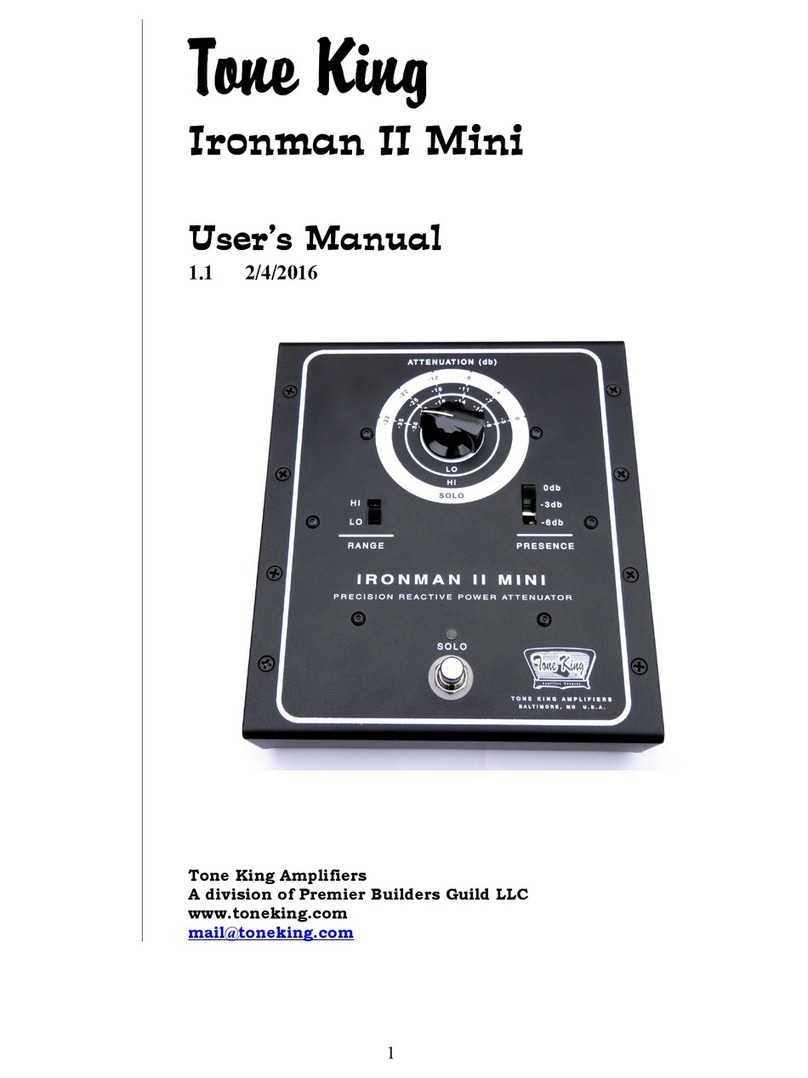
Tone King
Tone King Ironman II Mini User manual
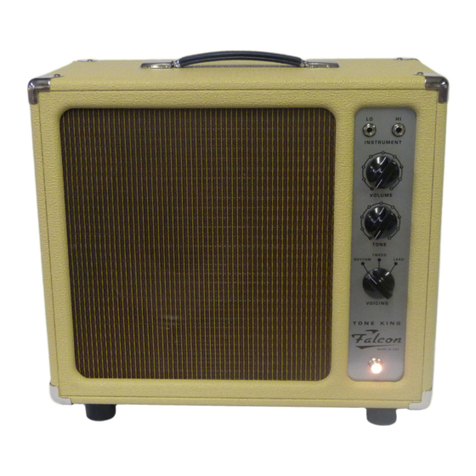
Tone King
Tone King FALCON User manual
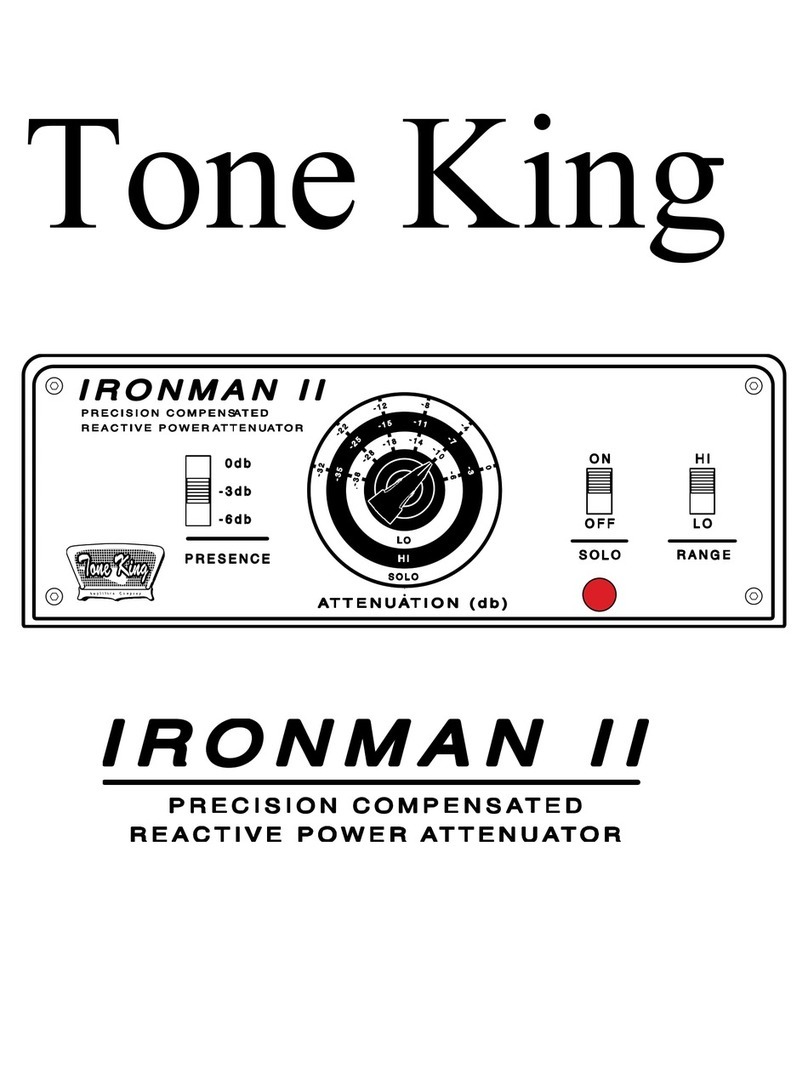
Tone King
Tone King Ironman II User manual

Tone King
Tone King Falcon Grande User manual
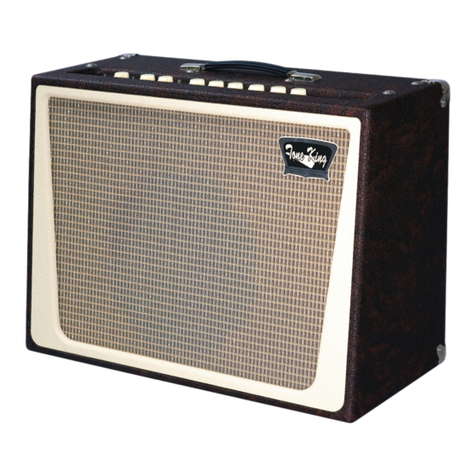
Tone King
Tone King Metropolitan User manual
Popular Amplifier manuals by other brands

Nobsound
Nobsound NS-08E user manual

Lake People
Lake People PHONE AMP G109 P user manual
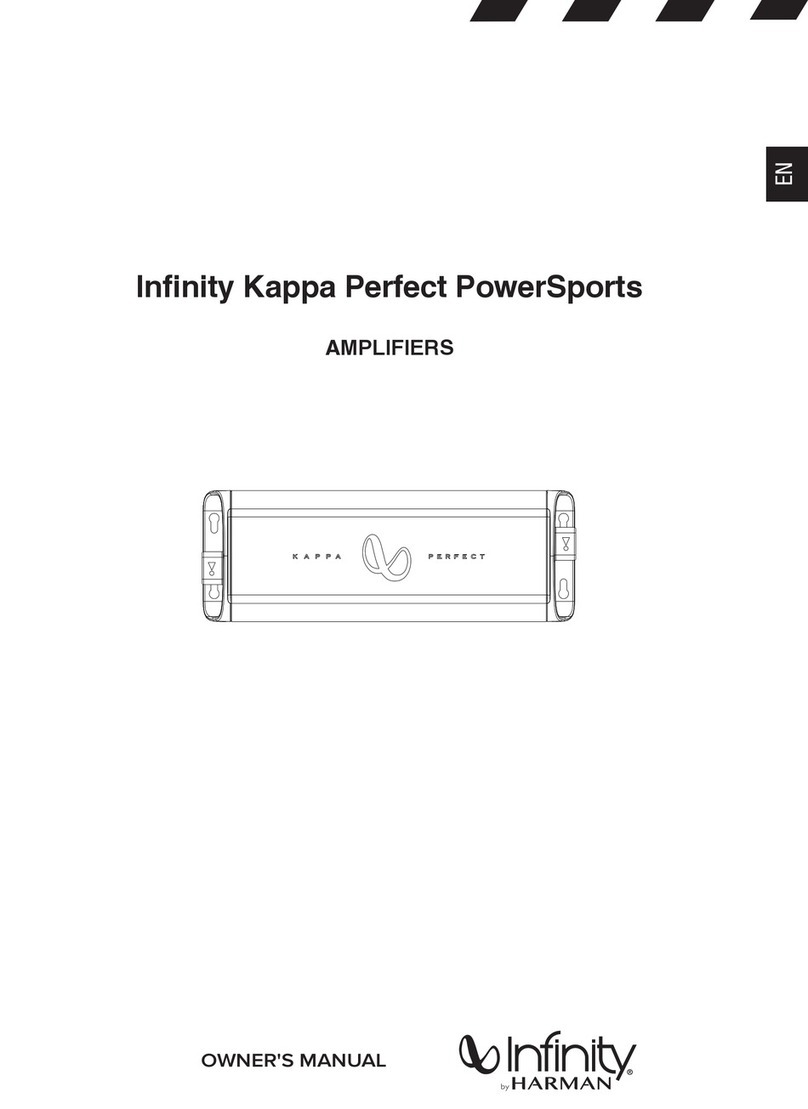
Harman
Harman Infinity Kappa Perfect PowerSports owner's manual
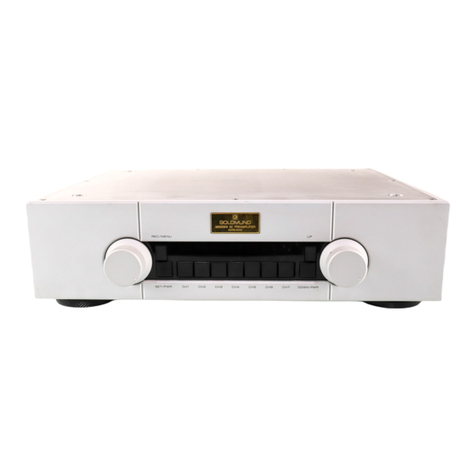
Goldmund
Goldmund MIMESIS 22 SIGNATURE user manual
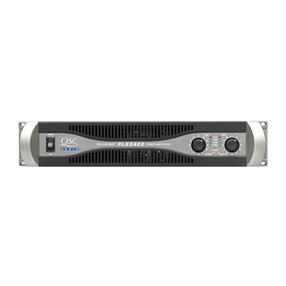
QSC
QSC PLX Series Technical & service manual

Cincinnati Bell
Cincinnati Bell iMeet and Plantronics Voyager quick guide
